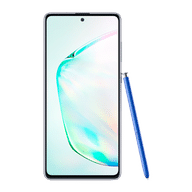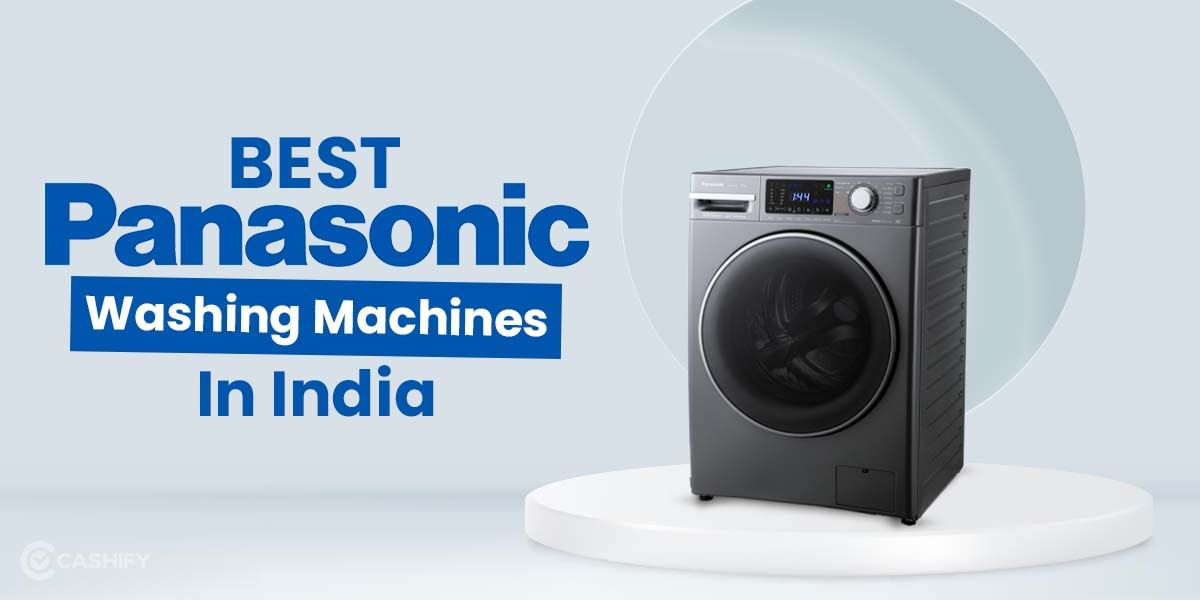Prices in India, Variants, Availabiity
The first affordable flagship with S-Pen is available at a price tag of Rs.38,999 for the base variant with 6GB RAM, while the 8GB RAM variant costs Rs.40,999. There is an exchange offer of upto Rs.5000 extra off on upgrading to Note 10 Lite.
The smartphone has been launched in three colour options – Aura Glow, Aura Black, and Aura Red.
Box Contents
The box design of the new Lite series is pretty much the same as the usual Note 10 with ‘Lite’ branding visible on the box, which otherwise looks identical to the Note 10. The retail unit of the Samsung Galaxy Note 10 Lite includes:
- The phone itself
- TPU case
- User manual and paperwork
- USB Type-C cable
- 25W fast charging adapter
- In-ear style earphones with 3.55mm connector
- Extra S-Pen tips
Specs at a glance
- Display: 6.7-inch Super AMOLED (2400 x 1080)
- CPU and GPU: Exynos 9810 Processor
- RAM and Storage 6/8/GB RAM, 128GB
- Rear Camera: 12MP ultra-wide (f/2.2), 12MP wide angle (f/1.7), 12MP telephoto (f/2.4)
- Selfie Camera: 32MP Front Camera
- Battery: 4,500 mAh Li-Polymer
- Security: In-display Fingerprint Scanner, Face Unlock
Design and Build
While the Note 10 Lite inherits its name from the usual Note 10, the design is pretty different, particularly at the back. At the front, we get a large 6.7-inch Super AMOLED display with a Full-HD+ (1080×2400 pixel) resolution and HDR support. Just like the Note 10, the Lite series comes with a punch hole for the selfie camera. The display size is large when comparing it to the Galaxy Note 10 sporting a 6.3-inch panel. The camera hole is small and unobtrusively placed towards the top edge.
One of the most prominent differentiating things about the design is the replacement of the curved display with slightly rounded corners, which do facilitate comfortable handling. We personally loved the curved design on Samsung flagships, although it did make the screen delicate and prone to damage even on slight bumps and drops. But considering the price point, we can accept this change.
Coming to the back, the glass back on the Note 10 has been replaced with a glass-like panel, which Samsung calls as ‘Glastic,’ i.e., a mixture of glass and polycarbonate. This might be a disappointment for many, as most other smartphones offer glass or metal back at this price point. The absence of glass back also makes the device void of wireless charging, which is sad. This also makes the Note 10 Lite to not look as premium and appealing as the parent Note 10, especially from the back. A new rectangular camera module, which we have earlier seen on previous Samsung devices such as the Galaxy M30s, can be seen at the back, housing a triple camera setup.
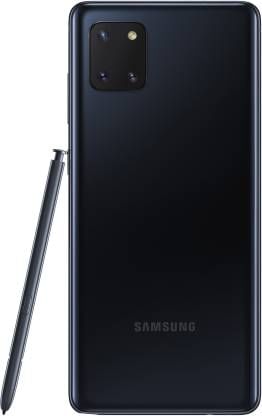
The placement of buttons on the Note 10 Lite is the same as the Note 10 with the volume and power buttons on the right. The power button can also be used to turn on ‘Bixby’ by default. As usual, the SIM tray is at the left while the bottom of the smartphone houses the Type-C port, speaker grille, and the S-Pen silo. And fortunately, we also find the 3.5mm headphone jacks at the bottom, which remained to be missing on the usual Note 10.
Overall, design-wise, other than the modern Infinity-O display at the front, the Note 10 Lite does lag behind its rivals, such as the OnePlus 7/7T, which feels a bit more premium with an appealing glass back.
Check out our review for the OnePlus 7T to get more details.
Display
Display configuration is one of the USPs of all Samsung smartphones. We have often seen Samsung handsets winning over other smartphones of the same price segment, offering a better specification, just due to their impressive displays. Talking about the Note 10 Lite, it comes with a 6.7-inch full-HD+ (1080×2400 pixels) Super AMOLED display with a punch-hole design and 20:9 aspect ratio, which covers almost the entire front with slim bezels all around. A worthy thing to note is that Samsung uses QHD panels on other smartphones of the S10 series as well as the Note 10 series (except the Note 10), but decided to stick with the basic Super AMOLED display on the Note 10 Lite. This ‘Infinity-O’ display comes with a pixel density of 395ppi, and this design is similar to what we have seen in the Galaxy Note 10/ Note 10+. The punch hole position on the Note Series is in a dead center position where you’re most likely going to forget about it after a couple of days or two. You also get an in-display fingerprint sensor like the usual Note 10.
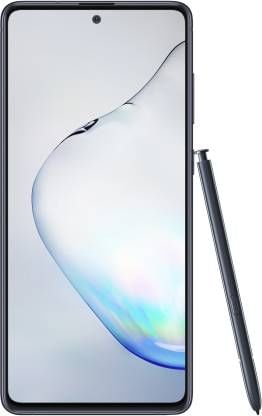
Despite the absence of the QHD resolution, we didn’t notice much difference in the overall viewing experience. Like any Samsung display, the display on the Note 10 Lite is vibrant, with punchy colours and deep blacks. Thanks to the Widevine certification and HDR+ support, media streaming was great, and playing games was a true delight. We experienced great outdoor visibility and good viewing angles. The display quality is as good as in any other Samsung device. An important fact is that it doesn’t have 120Hz or 90Hz refresh rate, which is a major missing considering the fact that most other smartphones of 2019 and in the same price segment, such as the OnePlus 7T, do offer higher refresh rates. This shouldn’t be a deal-breaker as most of us usually do not use higher refresh rate functionality for the sake of battery saving.
Performance
One of the most neglected things by Samsung are performance-related capabilities in its smartphones, especially the mid-range and budget smartphone segment. Talking about the Note 10 Lite, it is powered by the Exynos 9810 SoC, not the Qualcomm Snapdragon 855 SoC, which powers the usual Note 10 and even the new Galaxy S10 Lite. This is a kind of disappointment as the processor is two years old and was used to power the old Galaxy S9 and the Note 9. We did not expect a processor this old on a smartphone at this price point today.
Coming to real-life experience, the Exynos 9810 does work pretty well even today, and you won’t realize using a two-year-old chipset till you run benchmarks at look at the numbers.
Coupled with either 6GB or 8GB of RAM, the device gives no sign of slowing down. Multitasking was a boon; app refreshing was smooth, and the overall user experience went seamlessly with everything being fluid and without any hint of lag whatsoever. The configuration is great for app handling, but not for intense graphic games. While it is a capable chip on its own, we did notice performance dips and slight heating under heavy pressure, but that is what you have to deal with. Coming to storage, even if you feel that the 128GB internal storage is not enough for you, it can later be expanded using a microSD card.
Software
Talking about the software, it seems that Samsung has worked a lot on developing and improving its custom UI in its smartphones over the past years. The dual-SIM phone runs Android 10-based One UI 2 software – that’s the best from Samsung right now. One UI 2 is cleaner, refined, and optimized for newer Galaxy smartphones. Animations are very fluid, and gesture navigation is very snappy. The custom UI also brings many useful applications such as Bixby, the full version of Samsung Pay, and Samsung Health. We also get support for the improved and updated defense-grade security platform, Samsung Knox. The system-wide dark theme works on almost all third-party apps like Chrome and Instagram. Features like always-on display and Samsung Pay, which have been a mainstay on Samsung phones for several generations, are back. With One UI on top of Android 10, you get an incredible amount of customizability.
Cameras
Samsung hasn’t compromised with the camera configuration in its Lite series. We get an impressive triple camera setup at the back and a single selfie camera residing in the punch hole at the front. The triple-lens set-up of the device includes three 12-megapixel cameras with the primary having an f/1.7 aperture as well as OIS, the second being a wide-angle camera with an f/2.2 aperture, and the third being a telephoto camera having an f/2.4 aperture. The camera is yet another impressive thing that the Note Lite inherits from the usual Note 10.
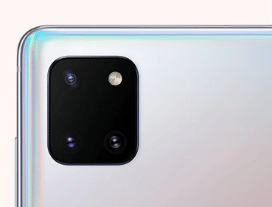
Although being a budget-priced version of the Note 10, the Lite has some pretty nifty features of its own. A major thing to note is the absence of dual-pixel autofocus, which results in somewhat slower focusing in comparison to the usual Note 10. The pictures with the primary camera came out to be stunning during day time with cooler colour tones but retaining a balanced amount of sharpness and dynamic range. The results can be put this camera at least on par with the flagship devices from Samsung and definitely above its rivals, such as those from OnePlus.
Talking about photos in low lighting conditions, the results came out decent. Although we did notice a bit of over-processing and expected some more refined results during low light. The dedicated night mode does help a lot and manages to bring out some details in the shadow areas, though noise still creeps in. The images were sometimes not that sharp, but overall the pictures came out with a good amount of detail and colour accuracy, and in certain scenarios, it managed to produce better pictures than the OnePlus 7T. The ultra-wide and 2x telephoto camera gets the job done well enough. But both of them do suffer from lack of detail, especially when you zoom in, and noise creeps in on indoor shots, but having the option of multiple lens camera makes the Note 10 Lite camera a versatile one. Like any other Samsung device, we also get a dedicated scene optimizer, which automatically adjusts settings based on kind of objects or scenery being shot.
Talking about selfies, we get a 32MP Selfie camera with an f/2.2 aperture on the front, which gives zoomed-in view by default, but you do have the option to switch to a wider frame. The selfies manage to gather a decent amount of details. The dynamic range is quite good too. The camera app has a handful of other camera features, including beautification, which is enabled by default, Live focus in images and videos, zoom mic in-camera, AR Doodle, super slow-mo video recording, hyper-lapse, and more.
On the video front, we get support for recording 4K 60fps for the primary camera and 4K 30fps for the selfie shooter. We do get electronic image stabilization, and you do have the option to switch between the three rear cameras while shooting. Shooting modes such as Live Focus Video, Super Slow-Mo, and Pro are also offered. Details are quite good during the daytime, and it gets progressively bad as light levels drop.
The S-Pen
The sole reason you would think of buying a ‘Galaxy Note’ device instead of a device from the S series or any other brand would be the S-Pen. We have seen the S-Pen on Note series to improvise year after year, add various utility features and with the latest one on the Note 10, we are offered with Bluetooth connectivity. It also has a 0.7mm tip with 4,096 pressure levels giving it more precision than ever. Luckily, the Lite version of the usual Note 10 doesn’t disappoint when it comes to S-Pen features as it retains almost all key S-Pen features that you see on the parent Note 10.
The usual set of features like Air Command, AR Doodle, Air Actions, Live Message, on-screen notes, Screen Off Memo, doodle, remote control functions built into Gallery, Media, and Camera apps along with the ability to hover over text for translation in real-time can also be seen. You also let the newly added feature to the S-Pen which was first seen on the Note 10; the ability to jot down things using the S Pen, and then instantly converting it into text.
Battery
Another upgrade to the Lite version of the Galaxy Note series is the massive 4500mAh battery over the smaller 3500mAh present on the Note 10. But what’s even more interesting is that there’s 25W fast charging support with the device, and you do get a 25W charger in the box. This definitely gives the phone a leg up over the Note 10.
Samsung’s recent phones have struggled with battery life. But with the Note 10 Lite, even with heavy use that included placing calls, browsing social media, and taking pictures, the battery never fell under 15% by the end of the day. Talking about charging time, the bundled 25W charger delivers up to a 60% charge in just over 30 minutes and a little over an hour to get it to a full charge.
Audio and Security
Regarding audio, luckily, we do get the 3.5mm headphone jack. Samsung does bundle a pair of basic in-ear earphones in the box, which is of decent quality but not as premium as the AKG ones that you get with Samsung flagships. As assumed, we do not get stereo speakers on the Note 10 Lite, which is acceptable. Talking about speakers, we have a single loudspeaker on the bottom, which is decently clear but mediocre when it comes to loudness. It can get loud, but the audio becomes somewhat muffled. The call quality was decent too, and we experienced no issues, neither with the earpiece nor with network reception.
One of the major things which are on the slower side is unlocking the device using face or the optical fingerprint scanner, which is optical and not ultrasonic. The standard CMOS fingerprint scanner makes the unlocking process a bit slow as compared with the Galaxy Note 10 and even with the OnePlus 7T. The same complaint we had with the face unlock feature. It is almost unusable in darker scenarios, and was not that fast even in good lighting conditions, and even failed to recognize the face occasionally. We assume that an update to fix this should be released.
Pros & Cons
Pros:
- Modern design
- In-display fingerprint sensor instead of a physical scanner
- 3.5mm headphone jack
- Eye-catching, massive Super AMOLED display
- Impressive triple camera configuration
- Massive battery with fast charging support
- Latest, improved version of One UI
- Most affordable Samsung device with S-Pen support
Cons:
- The back panel doesn’t look premium due to the absence of Glass
- Old school 60hz refresh rate
- Two-year-old chip makes it lag behind its rivals
- Quad HD+ resolution is a missing
- No dust or water resistance
- No wireless charging
- No stereo speaker
- Slow and laggy in-display fingerprint sensor
- Low-light photography could have been better
Many of the users in the market might have loved the Note 10 Lite, whereas many would still feel if the compromises made are worth enough or not. Bringing the S-Pen equipped Note 10 Lite to an affordable price range opens up a plethora of possibilities, thus attracting a lot of stylus lovers.
The S-Pen does make this unique in this segment, but the old processor acts as a handicap. To sum up, we can say if you can sacrifice the S-Pen, there are plenty of other alternatives, one of which is the Galaxy S10 Lite, offering a much better Snapdragon 855 chipset. But otherwise, if you are attracted to the Note series and can sacrifice a Quad HD resolution (which most of us can), you can get the same features of the flagship Note 10 series at a much lower price. Presence of one of the decently reliable processors, impressive out-door photography, decent low-light photography, interesting S-Pen features, and a massive 4500mAh battery along with 25W fast charging are some of the other things that make the Note 10 Lite a bang for the buck.
However, there are still things missing in this package. Absence of wireless charging, 3.5mm headphone jack, and dust/water resistance can really be a deal-breaker. Rivals such as the OnePlus 7T would offer a slightly faster processor, a glass back, and a higher 90hz refresh rate display at around Rs. 5,000 less than the Note 10 Lite. However, if you think that you are really comfortable with these compromises that Samsung made with its latest “Lite Flagship,” the Note 10 Lite is a very impressive offering from the company, especially for those who really wish to own a ‘Samsung’s Note series’ device in the under Rs 40,000 segment, passing on key Samsung strengths at a less-than-flagship price.



